world.wikisort.org - United_Kingdom
The West Midlands is one of nine official regions of England at the first level of International Territorial Level for statistical purposes. It covers the western half of the area traditionally known as the Midlands. The region consists of the counties of Herefordshire, Shropshire, Staffordshire, Warwickshire, West Midlands and Worcestershire. The region has seven cities Birmingham, Coventry, Hereford, Lichfield, Stoke-on-Trent, Wolverhampton and Worcester.
This article needs additional citations for verification. (March 2022) |
This article contains too many pictures that are sandwiching text or an indiscriminate collection of Image galleries for its overall length. (July 2022) |
West Midlands | |
|---|---|
Region of England | |
 | |
| Sovereign state | United Kingdom |
| Constituent country | England |
| Largest city | Birmingham |
| Largest urban area | West Midlands conurbation |
| Counties | Herefordshire Shropshire Staffordshire Warwickshire West Midlands Worcestershire |
| Government | |
| • Leaders' board | West Midlands Councils |
| Area | |
| • Total | 5,019 sq mi (12,998 km2) |
| • Rank | 7th |
| Population (2021 census) | |
| • Total | 5,950,800 |
| • Rank | 5th |
| • Density | 1,200/sq mi (460/km2) |
| GVA | |
| • Total | £110 billion |
| • Per capita | £17,161 (7th) |
| ITL code | TLG |
| This article is part of a series within UK politics on the |
Politics of England |
|---|
 |
|

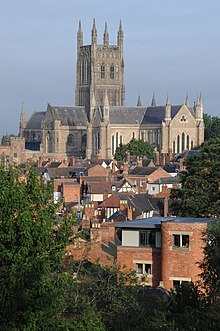
The West Midlands region is geographically diverse, from the urban central areas of the West Midlands conurbation to the rural counties of Herefordshire, Shropshire and Worcestershire which border Wales. The region is landlocked. However, the longest river in the UK, the River Severn, traverses the region southeastwards, flowing through the county towns of Shrewsbury and Worcester, and the Ironbridge Gorge, a UNESCO World Heritage Site. Staffordshire is home to the industrialised Potteries conurbation, including the city of Stoke-on-Trent, and the Staffordshire Moorlands area, which borders the southeastern Peak District National Park near Leek. The region also encompasses five Areas of Outstanding Natural Beauty, the Wye Valley, Shropshire Hills, Cannock Chase, Malvern Hills, and parts of the Cotswolds. Warwickshire is home to the towns of Stratford upon Avon, birthplace of writer William Shakespeare, Rugby, the birthplace of Rugby football and Nuneaton, birthplace to author George Eliot.
Geography
The official region contains the ceremonial counties of Herefordshire, Shropshire, Staffordshire, Warwickshire, West Midlands and Worcestershire.
There is some confusion in the use of the term "West Midlands", as the name is also used for the much smaller West Midlands county and conurbation which is in the central belt of the Midlands and on the eastern side of the West Midlands Region. It is also still used by various organisations within that area, such as West Midlands Police and West Midlands Fire Service.
The highest point in the region is Black Mountain, at 703 metres (2,307 ft) in west Herefordshire on the border with Powys, Wales.
The region contains five Areas of Outstanding Natural Beauty (AONBs), including the Shropshire Hills, Malvern Hills and Cannock Chase, and parts of the Wye Valley and Cotswolds. The Peak District national park also stretches into the northern corner of Staffordshire.
Towns and cities
Major towns and cities in the West Midlands region include:[1]
- Bold indicates city status.
|
|
|
 Ceremonial county Unitary authority or metropolitan borough Motorway Area of Outstanding Natural Beauty National park
|
Urban areas
The West Midlands region contains several urban areas with populations of 100,000 or more in 2020, which include:[2]
- West Midlands conurbation (includes Birmingham, Wolverhampton, Solihull, Sutton Coldfield, Dudley, West Bromwich and Walsall.) (Pop: 2,582,044)
- Coventry and Bedworth urban area (includes Coventry, Bedworth and Binley Woods.) (Pop: 422,188)
- Stoke-on-Trent built-up area {includes Stoke-on-Trent, Newcastle-under-Lyme and Kidsgrove) (Pop: 384,819)
- Telford (Pop: 158,114)
- Worcester (Pop: 103,474)
- Royal Leamington Spa Built-up area (includes Leamington Spa, Warwick, Whitnash, Cubbington) (pop: 100,740)
Modern history
World War II
The RAF Fauld explosion on 27 November 1944 in east Staffordshire produced a 100-foot deep crater, and is the UK's largest explosion, being caused by around 4,000 tonnes of high explosive, and may be the world's largest non-nuclear explosion.
Birmingham was the third most bombed city in the UK after London and Liverpool; Spitfires were built in Castle Bromwich, Lancasters at Austin's works in Longbridge at Cofton Hackett, and the Birmingham Small Arms Company at Small Heath produced the M1919 Browning machine gun. Boulton Paul Aircraft had their main aircraft factory in the north of Wolverhampton. RAF Defford, in the south of Worcestershire between Pershore and Croome Park, was where many important airborne radars were developed, such as H2S (radar) and anti-submarine radars.
Scientific heritage
Thomas Wedgwood, son of Josiah Wedgwood, discovered the first photo-sensitive (light-sensitive) chemicals – silver nitrate and silver chloride in the 1790s.
Sir Norman Lockyer of Rugby discovered helium in 1868, for which he used electromagnetic spectroscopy.
Edward Weston of Oswestry, who emigrated to the US, built the first accurate voltmeter in the late 1880s, and the Weston cell in 1893.
Francis W. Aston of Harborne, educated at the University of Birmingham, developed mass spectrometry in 1919, which helped him to identify the first isotopes, receiving the Nobel Prize for Chemistry in 1922.
Dennis Gabor invented holography at British Thomson-Houston in Rugby in 1947, receiving the Nobel Prize for Physics in 1971.
James Glaisher in 1862 took a record balloon flight with Henry Tracey Coxwell for the BAAS near Wolverhampton. They reached 29,000 feet (8,800 m) the composition of the Earth's atmosphere until then was not understood; the altitude records for the UK have not been exceeded since; Project Excelsior in the US in 1960 would later reach 20 miles (110,000 ft).
Philip Lawley of Burton upon Trent was first person to realise that chemical damage to DNA caused cancer (at the Chester Beatty Research Institute in London) in the early 1960s.
Francis Galton (d. 1911) of the Darwin–Wedgwood family's Birmingham branch was an early eugenicist rooted in improving animal breeding stock and examining heredity. He invented terms eugenics and nature versus nurture. His limited calls for human eugenics were widened by the German Society for Racial Hygiene in 1905 founded by Alfred Ploetz, which coupled with the racial superiority fallacies of Aryanism reached its nadir in genocidal anti-semitism. Moral teachings and inherent repulsions towards human eugenics were overcome by a minority of those in power espousing racial equality; European media and leaders lamented loss of Empire, advocated ultranationalism and prized military physical advantage; Galton saw human eugenics as part of all means to do better.
Industrial heritage

Much of the Industrial revolution in the United Kingdom began in Birmingham and the Black Country area of West Midlands. The Industrial Revolution is thought to have begun when Abraham Darby substituted coke in the place of charcoal to smelt iron, at his Old Furnace. The Black Country may be regarded as the world's first industrial landscape,[3] while nearby Ironbridge Gorge claims to be the Birthplace of Industry.[4] The world's first cast iron bridge in 1779 spans the Gorge. The first self-propelled locomotive to run on rails in 1803 at Coalbrookdale, was built by Richard Trevithick. The first iron rails for horse-drawn transport, were made at Coalbrookdale in 1768 by Richard Reynolds at Ketley Ironworks. Iron rails only became widely successful in 1820 when made out of wrought iron at Bedlington Ironworks in north-east England.

Birmingham's industrial development was triggered by discussions at the Lunar Society of Birmingham at Soho House, Boulton's house, and products were carried along the BCN Main Line canal. Soho Manufactory was the first man-made-powered factory in world. Chance Brothers of Smethwick built the glass for The Crystal Palace in 1851. Smethwick Engine, now at Thinktank, Birmingham Science Museum, is the oldest working steam engine, made in 1779, and is the oldest working engine in the world. Smethwick was a main centre for making lighthouse lanterns.
Valor Fires in Erdington developed the first radiant gas fire in 1967, a balanced flue fire in 1973, and a natural flame gas fire in 1978. The Erdington site, owned by Iceland's BDR Thermea, closed in May 2012. The company also built gas cookers; since 2011 the company has been part of Glen Dimplex, who have a site at Cooper's Bank, south of Gornalwood.
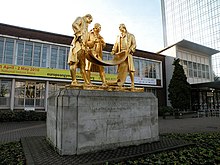
Ditherington Flax Mill in Shrewsbury was the first iron-framed building in the world in 1797. Thomas Bolton & Sons of Froghall, Staffordshire, made the world's first transatlantic telegraph cable in 1857, having supplied a submarine cable across the English Channel in 1850. GEC Telecommunications was headquartered at the GEC Telephone and Radio Works in Coventry, it has now become the New Century Park, off the A428 north of Stoke Aldermoor in eastern Coventry. On 10 July 1890, a trunk circuit telephone line was opened between London and Birmingham by the National Telephone Company; for the first time this allowed phone calls between the London and the north.[5] The world's first coaxial cable was laid between London and Birmingham in 1936 to give 40 channels for telephone traffic.[6] and brought into use in 1938, later extended to Manchester in 1940.

Alexander Parkes invented the first man-made plastic (thermoplastic) in Birmingham in 1856. Arthur Leslie Large of Birmingham is credited with inventing the kettle in 1922. Princess Square, Wolverhampton, was the site of Britain's first traffic lights in 1927. Infrared cameras were developed at the Royal Radar Establishment in Malvern (with EMI Electronics) in 1967. The world's first Maglev train operated at Birmingham Airport in 1983. The tallest freestanding structure in the region was the chimney of Ironbridge power station at 673 ft. John Baskerville of Birmingham, a former stone carver, largely invented fonts, or typefaces, for printing.
Much of the UK's car industry would be centred in Coventry and Birmingham; most of this has now gone. Midland Motor Cylinder (part of Birmid Industries) of Smethwick was the largest producer of automobile cylinder blocks in Europe. Fort Dunlop was Europe's largest tyre plant. Metro-Cammell in Birmingham made most of the 1970s and 1980s London Underground trains. MG Rover (a company of Rover) closed in 2005 (from 1885), The Ryton plant, which made the Peugeot 206, closed at the end of 2006, with production moving to Trnava in Slovakia, and some to a plant at Kolín in the Czech Republic. Alfred Herbert of Coventry was the largest machine-tool manufacturer in the UK for many decades; it was brought down in the 1970s by advancing technology overseas, and complacent strategic decisions of the management (caught like a rabbit in the headlights), finally closing in 1982; many Midlands manufacturing companies followed similar fates in the 1970s and 1980s.
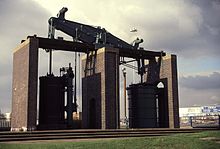
Henry Wiggin & Co of Hereford developed the metal alloys necessary for other Midlands' (and beyond) automotive and aerospace companies – Inconel, Incoloy and Nimonic. It was the lack of vanadium for high-melting point alloys, caused by Royal Navy action, that prevented German Me 262 engines being serviceable; had German World War 2 engineers had a greater supply of vanadium and molybdenum, the engine life (around 12 hours maximum, from entering service in April 1944 to the end of the war) of their jet engine would have increased much more, which would have been significant to the war's outcome. Bristol Siddeley developed the rocket engines for Black Arrow at Ansty; in fact all of R-R's rocket engines were developed and built there at R-R's Industrial and Marine Gas Turbine Division; Britain's smaller rocket engines for missiles were built by Bristol Aerojet in what is now North Somerset. High Duty Alloys at Redditch constructed (forged) the compressor and turbine blades for Whittle's first engines, and many of the early jet engines; it made Concorde's airframe from the Hiduminium R.R.58 aluminium alloy.
Maxaret, the world's first ABS braking system, was invented in Coventry by Dunlop in the early 1950s for aircraft; John Boyd Dunlop was a Scottish vet who had first produced the first pneumatic tyres in 1889. Matthew Piers Watt Boulton, grandson of Matthew Boulton, and born in the area, invented the aileron, an important flight control surface in 1868, decades before the first actual flight. Triumph Engineering was a famous motorbike firm in Meriden. About a quarter of all British WWI planes were built in Coventry. The Jensen Interceptor FF was the first production four-wheel-drive car in the world, designed by Major Tony Rolt, and built at their factory in West Bromwich.
Cadbury launched Dairy Milk in 1905, Bournville in 1906, Fruit & Nut in 1928, Whole Nut in 1930, Cadbury Roses in 1938, and the Cadbury Creme Egg in 1971. George and Richard Cadbury built their factory in 1879 and Bournville in 1893, named after the Bourn brook. Iceland (supermarket) opened its first store in Oswestry in 1970 – heralding the onset of frozen food in the UK. Alfred Bird invented egg-free custard in 1837 in Birmingham – accidentally given to guests at his home, being created as his wife had an allergy to eggs; he then invented baking powder in 1843 as his wife also had an allergy to yeast.
Culture
J. R. R. Tolkien grew up in Birmingham, Kings Heath, then part of Worcestershire, and was inspired by Moseley Bog and Sarehole, and perhaps by the Perrott's Folly. Philip Larkin came from Coventry. Rowland Hill (stamps) was from Kidderminster. The writer George Eliot came from Nuneaton. Anthony E. Pratt from Birmingham invented Cluedo.
Frederick Gibberd of Coventry designed Liverpool Metropolitan Cathedral. Edward Cave from Rugby made Britain's first magazine in 1731 – The Gentleman's Magazine. Philip Astley from Newcastle under Lyme invented the modern day circus in 1768 – Astley's Amphitheatre.
The Castlemorton Common Festival in May 1992 near Malvern, led to the Criminal Justice and Public Order Act 1994.
The Nowka Bais is a Bengali boat racing festival which takes place annually in Birmingham. It is a cultural event in the West Midlands, United Kingdom attracting not only the Bangladeshi diaspora but a variety of cultures.[7] It is also the largest kind of boat race in the United Kingdom.[8]
Regional assembly
The official representative body of the region is the West Midlands Leaders Board which has limited administrative functions such as regional planning and economic development. The board is not an elected body, but is made up of members appointed from local councils across the region and is known as a quango. It is based on Edward Street in Birmingham, near the National Indoor Arena. From March 2010, the funding decisions at regional level were taken over by Advantage West Midlands, the Regional Development Agency.

Demographics
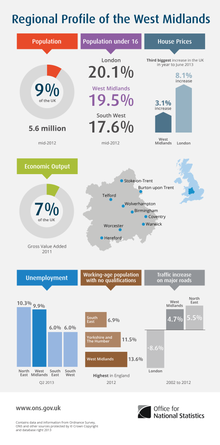
Ethnicity
The West Midlands is the second most ethnically diverse region of the UK (London being the most diverse). This is in large part due to the West Midlands conurbation, which is highly diverse. The ethnic makeup of the West Midlands as a whole as measured by the 2011 census was as follows:
| Ethnic group | 1991[9] | 2001[10] | 2011[11] | |||
|---|---|---|---|---|---|---|
| Number | % | Number | % | Number | % | |
| White: Total | 4,725,824 | 91.8% | 4,674,296 | 88.74% | 4,633,669 | 82.7% |
| White: British | 4,537,892 | 86.15% | 4,434,333 | 79.2% | ||
| White: Irish | 73,136 | 1.38% | 55,216 | 1.0% | ||
| White: Irish Traveller/Gypsy | - | - | 4,734 | 0.1% | ||
| White: Other | 63,268 | 1.2% | 139,386 | 2.5% | ||
| Asian or Asian British: Total | 297,829 | 5.8% | 401,672 | 7.62% | 604,435 | 10.8% |
| Asian or Asian British: Indian | 158,731 | 178,691 | 3.39% | 218 439 | 3.9% | |
| Asian or Asian British: Pakistani | 98,612 | 154,550 | 2.93% | 227,248 | 4.1% | |
| Asian or Asian British: Bangladeshi | 19,415 | 31,401 | 0.59% | 52,477 | 0.9% | |
| Asian or Asian British: Chinese | 9,588 | 16,099 | 0.3% | 31,274 | 0.6% | |
| Asian or Asian British: Asian Other | 11,483 | 20,931 | 0.39% | 74,997 | 1.3% | |
| Black or Black British: Total | 102,206 | 2% | 104,032 | 1.97% | 182,125 | 3.3% |
| Black or Black British: Caribbean | 78,082 | 82,282 | 1.56% | 86,794 | 1.6% | |
| Black or Black British: African | 5305 | 11,985 | 0.22% | 64,253 | 1.2% | |
| Black or Black British: Other | 18,819 | 9,765 | 0.18% | 31,078 | 0.6% | |
| Mixed: Total | 73,225 | 1.39% | 131,714 | 2.4% | ||
| Mixed: White and Caribbean | 39,782 | 0.75% | 68,533 | 1.2% | ||
| Mixed: White and African | 3,683 | - | 9,232 | 0.2% | ||
| Mixed: White and Asian | 18,160 | 0.34% | 32,561 | 0.6% | ||
| Mixed: Other Mixed | 11,600 | 0.22% | 21,388 | 0.4% | ||
| Other: Total | 24,328 | 0.47% | 14,083 | 0.26% | 49,904 | 0.9% |
| Other: Arab | - | - | 18,079 | 0.3% | ||
| Other: Any other ethnic group | 24,328 | 0.47% | 14,083 | 0.26% | 31,825 | 0.6% |
| Total | 5,150,187 | 100% | 5,267,308 | 100% | 5,601,847 | 100% |
Teenage pregnancy
For top-tier authorities in the West Midlands, Stoke-on-Trent has the highest teenage pregnancy rate. For council districts, Nuneaton and Bedworth in Warwickshire has the highest rate closely followed by Tamworth. For top-tier authorities, Shropshire has the lowest rate, and for council districts Malvern Hills has the lowest rate.
Social deprivation
The region, from studies of multiple deprivation, shows similarities with Yorkshire and the Humber, and is more deprived than the neighbouring East Midlands. From the Indices of deprivation 2007, it can be seen that, in common with Northern England, the region has more Lower Area Super Output Areas in the 20% most deprived districts than in the 20% least deprived districts.[12] The region's most deprived council districts, in descending order, are Birmingham (10th highest in England), Sandwell (14th), Stoke-on-Trent (16th), Wolverhampton (28th), Walsall (45th), Coventry (61st), and Dudley (100th).[13]
The least deprived districts in 2007 (before Shropshire became a unitary authority in 2009) were Bromsgrove, South Staffordshire, Warwick, Wychavon, and Lichfield. At county level, the least deprived areas, in descending order, were Warwickshire, Worcestershire, Solihull, Staffordshire, and Shropshire.
In March 2011 the region had the second highest overall unemployment claimant count in England at 4.7%, second to North East England. The highest in the region was Wolverhampton at 7.7%, the joint second highest (with Manchester) unemployment rate in England. Next is Sandwell with 7.1%, Birmingham with 7.0%, and Walsall with 6.4%. The lowest rate in the region is the district of Stratford-on-Avon, with 1.6% – one of the lowest unemployment rates in England.[14]
Politics
Elections
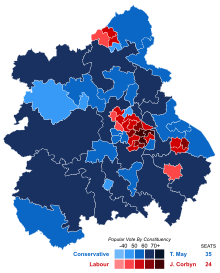
In the 1992 general election, Nuneaton was taken by Labour with a 7% swing, which was one of the largest swings of the night;[15] in the 2015 election, the Nuneaton result would largely seal the eventual outcome of the election. In the 2010 general election, North Warwickshire (Dan Byles) had the smallest Conservative majority, with 54; Stoke-on-Trent Central had the smallest number of winning votes, with 12,220.
In the 2015 general election, the Conservatives gained the largest share of the region by popular vote and took control of the number of seats, with 42% of the region's electorate voting Conservative, 33% Labour, 16% UKIP, 6% Liberal Democrat and 3% Green. The Conservatives gained 2 seats with virtually no swing from Labour to Conservative.[16]
In the 2017 general election, South Staffordshire (Gavin Williamson) had the second-highest Conservative vote proportion in the UK – 69.8%. David Firth, at the University of Warwick, invented the BBC election exit poll. 6 ft 9 Daniel Kawczynski, a Shropshire MP, is the tallest MP ever.
Although having a slightly smaller percentage of the vote than the neighbouring East Midlands, the geographic area of the West Midlands is more Conservative, due to Labour's vote now consigned to the urban areas of Birmingham, Coventry and Stoke-on-Trent. The number of seats is more favoured towards Labour than the geographic spread, with 35 Conservative seats and 24 Labour. All of Warwickshire, Staffordshire, Herefordshire, Worcestershire and Shropshire is now Conservative.
Political Parties
The Green Party of England and Wales was formed at the Bridge Inn in Napton-on-the-Hill, Warwickshire, in February 1973, originating from an article by Paul R. Ehrlich about population growth in Playboy magazine.[17] In 1975, it became the Ecology Party[18] and then the Green Party in 1985.[19]

Eurostat NUTS
In the Eurostat Nomenclature of Territorial Units for Statistics (NUTS), the West Midlands form a level-1 NUTS region, coded "UKG", which is subdivided as follows:
| NUTS 1 | Code | NUTS 2 | Code | NUTS 3 | Code |
|---|---|---|---|---|---|
| West Midlands | UKG | Herefordshire, Worcestershire and Warwickshire | UKG1 | Herefordshire | UKG11 |
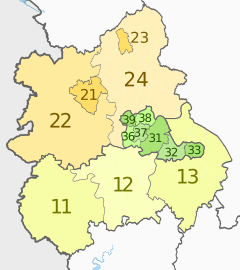 |
Worcestershire CC | UKG12 | |||
| Warwickshire CC | UKG13 | ||||
| Shropshire and Staffordshire | UKG2 | Telford and Wrekin | UKG21 | ||
| Shropshire | UKG22 | ||||
| Stoke-on-Trent | UKG23 | ||||
| Staffordshire CC | UKG24 | ||||
| West Midlands | UKG3 | Birmingham | UKG31 | ||
| Solihull | UKG32 | ||||
| Coventry | UKG33 | ||||
| Dudley | UKG36 | ||||
| Sandwell | UKG37 | ||||
| Walsall | UKG38 | ||||
| Wolverhampton | UKG39 | ||||
Local government
The region consists of the following administrative subdivisions:
| Map | Ceremonial county | Metropolitan or non-metropolitan county | Districts |
|---|---|---|---|
 | 1. Herefordshire (unitary authority area) | ||
| Shropshire | 2. Shropshire (unitary authority area) | ||
| 3. Telford and Wrekin (unitary authority area) | |||
| Staffordshire | 4. Staffordshire † | a) Cannock Chase, b) East Staffordshire, c) Lichfield, d) Newcastle-under-Lyme, e) South Staffordshire, f) Stafford, g) Staffordshire Moorlands, h) Tamworth | |
| 5. Stoke-on-Trent (unitary authority area) | |||
| 6. Warwickshire † | a) North Warwickshire, b) Nuneaton and Bedworth, c) Rugby, d) Stratford-on-Avon, e) Warwick | ||
| 7. West Midlands * | a) Birmingham, b) Coventry, c) Dudley, d) Sandwell, e) Solihull, f) Walsall, g) Wolverhampton | ||
| 8. Worcestershire † | a) Bromsgrove, b) Malvern Hills, c) Redditch, d) Worcester, e) Wychavon, f) Wyre Forest | ||
Key: †two-tier non-metropolitan county | *metropolitan county including the West Midlands Combined Authority and mayor
Demography
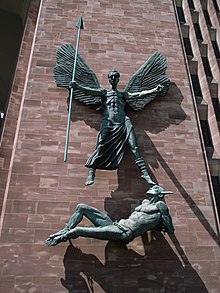
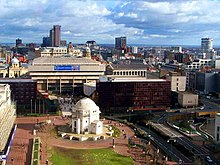
| Ceremonial County | Population | Population density | Largest local authority | Largest settlement |
|---|---|---|---|---|
| West Midlands (region) | 5,267,337 | 405/km2 | Birmingham (1,006,500) | Birmingham (1,006,500) |
| West Midlands (county) | 2,600,100 | 2,884/km2 | Birmingham (1,006,500) | Birmingham (1,006,500) |
| Staffordshire | 1,062,500 | 391/km2 | Stoke-on-Trent (240,636) | Stoke-on-Trent (259,252) |
| Worcestershire | 552,900 | 318/km2 | Wychavon (116,300) | Worcester (93,400) |
| Warwickshire | 522,200 | 264/km2 | Warwick (132,900) | Nuneaton (70,721) |
| Shropshire | 451,100 | 129/km2 | Shropshire (290,900) | Telford (138,241) |
| Herefordshire | 177,800 | 82/km2 | N/A[20] | Hereford (50,400) |
The West Midlands' population accounts for almost 11% of England's overall population. 49.36% of the region's population resides in the West Midlands county, 20.17% in Staffordshire, 10.49% in Worcestershire, 9.91% in Warwickshire, 8.56% in Shropshire, and 3.37% in Herefordshire.
Economy
This section needs additional citations for verification. (January 2017) |
Business Link West Midlands[21] was based on the Quinton Business Park in Quinton, next to Highways England. NHS West Midlands, the strategic health authority was in Edgbaston. The West Midlands Ambulance Service is in Brierley Hill, near the headquarters of West Midlands Police, where the Child Support Agency (CSA) was headquartered. The region's Manufacturing Advisory Service was on Wolverhampton Science Park, north of the city centre; this function is now represented by Made in the Midlands, north of Wolverhampton.[22]
The DIT West Midlands for the region[23] is based at the West Midlands Chambers of Commerce on Harborne Road, south of NHS West Midlands west of Five Ways. Most of the region is covered by the Midlands Air Ambulance, except Warwickshire is covered by the Warwickshire & Northamptonshire Air Ambulance, based at Coventry Airport; both are charity-funded. Sir Anthony Bamford of Staffordshire is the richest British industrialist, at around £3.15bn in 2014; Sir James Dyson is second (£3bn).
Herefordshire


Bulmers Cider in Hereford is the world's largest cider factory, and has the world's largest vat (for Strongbow), built in 1975. Painter Brothers (part of Balfour Beatty) in the north of Hereford, is the UK's largest manufacturer of electricity pylons (transmission towers), broadcasting masts, the Callender-Hamilton bridge, and rail electrification structures. Special Metals Wiggin, part of Special Metals Corporation, based at Hereford was the main producer of nickel alloys in Europe, with a large site directly north of Painter Brothers. Cargill Meats Europe (formerly Sun Valley) have a large poultry meat processing facility, processing chickens from around Herefordshire.
Cadbury (Mondelēz International) make milk chocolate crumb near Marlbrook (near Leominster). Weston's Cider is in Much Marcle, who also make Stowford Press. Wye Fruit Ltd is in the north of Ledbury on the B4214 and is a large site of Amcor, and further west is Universal Beverages (UBL), owned by Heineken since 2007 where it cans cider. The site of Ledbury Preserves of RHM made Robertson's jam, mincemeat and marmalade and closed in 2008 when production moved to Cambridgeshire. Holden Aluminium Technologies are a sports car chassis manufacturer at Linton. Kingspan Insulation is based at Pembridge. BT's Madley Communications Centre, claims to be the world's largest earth station. Tyrrells Potato Crisps are at Dilwyn west of Leominster.
Shropshire
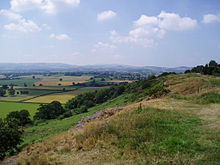
Rayburn Range and Aga Rangemaster Group are based in Telford; the PDSA is in St George's and Priorslee, Telford. The MoD have a significant depot at Lilleshall and Donnington. There are also high-technology industries such as Unimation, Nikon, Hitachi Maxell, Ricoh, Capgemini, Fujitsu and Electronic Data Systems. In Hadley Castle, Denso Manufacturing UK Ltd make car air-conditioning systems and GKN Wheels make car wheels. Makita Manufacturing Europe at Hortonwood, Telford is the only plant in the UK that makes power tools.[citation needed]
Müller Dairy Ltd is based in Market Drayton, and Palethorpes, part of Pork Farms which makes own-label sausages. At Crudgington, Dairy Crest made Country Life butter and Clover until February 2015, and have their Technical Centre. Anglo Beef Processors (ABP Food Group) are at Harlescott in the north of Shrewsbury. Nearby Stadco, a metal pressings company, are based in the Battlefield Industrial Estate and have a site at Hadley Castle, Telford. Uniq plc have a plant at Minsterley and make chilled desserts for Tesco.
BT have their National Network Management Centre (Whittington House) in Whittington, Shropshire. Military helicopter training in the UK takes place at RAF Shawbury, alongside training for the RAF's air traffic controllers (ATC).
Staffordshire

The brewing companies such as Coors Brewers are in Burton on Trent, as well as Marmite, Marston's Brewery, GNC UK (health supplements), and Doncasters (aerospace components and steel forging, founded by Daniel Doncaster of Sheffield). Conder Structures is a structural steel company next to Marmite, and further south Johnson Controls make seats for Toyota in Branston and yes, Branston is the original home of Branston Pickle, where the original factory can still be seen on Burton Road. Spirit Pub Company is near the A5121/A38 junction, with Punch Taverns slightly further north. Marley Eternit, who make Eternit fibre cement roofing (often seen on industrial buildings) are based in the south of Branston.

Newell Rubbermaid UK (owner of Parker Pen, Berol, Paper Mate and DYMO), a large RDC of Tesco, and Zytek (motorsport) is at Fradley Park, on an old airfield. Norgren was an international pneumatic technology company on Eastern Avenue, Lichfield.
Michelin Tyres are made at Sideway in Stoke-on-Trent. Royal Doulton and Wedgwood were/are based at Burslem and Barlaston respectively. Portmeirion Pottery, which owns the Royal Worcester brand, is in Stoke. Steelite International (pottery) is based at Middleport, in west Burslem, next to the Trent and Mersey Canal. Wade Ceramics is at Etruria to the east of Wolstanton, near the HQ of the Sentinel newspaper (Harmsworth Printing). Premier Foods make Mr Kipling slices and Cherry Bakewells at Trent Vale in the south of Stoke-on-Trent.
Bet365 is situated at Festival Park in Etruria, and is Stoke-on-Trent's largest private sector employer. Dechra Pharmaceuticals makes veterinary pharmaceuticals at Talke. Churchill China is at Sandyford near Tunstall. Sumitomo Electrical Wiring Systems (Europe), which supplies wiring for the automotive industry, is at Silverdale. At Kidsgrove, Converteam make variable speed drives (VSDs); AAH Pharmaceuticals has its Enterprise and Trident divisions in Talke, in the west of Kidsgrove. Andritz UK is at Wolstanton, in the north of Newcastle.

. Mann+Hummel UK, at Featherstone, make air and oil filters. Armitage Shanks (owned by Ideal Standard International) is to the east of Rugeley in Armitage with Handsacre; JCB Cab Systems was next to the A51 on the Riverside Industrial Estate.
The UK headquarters of GE Grid Solutions is based at Stafford as well as a factory and the UK headquarters of Bostikon Common Road, in the north of the town. Altecnic, which works with Caleffi of Italy, is to the north of Stafford in Creswell, and supply plumbing fittings.
Numark Pharmacy is at Tamworth. Bristan based in Dordon and Baddesley Ensor on the Birch Coppice Business Park south-west of Tamworth, next to a new Ocado distribution centre, is the UK's largest supplier of kitchen and bathroom taps; Volkswagen Group (VAG UK) have their main UK distribution facility there, the site of Birch Coppice Colliery before 1987; nearby Maersk have their Birmingham Intermodal Freight Terminal. Ansell UK (medical gloves, from Australia) is on Tamworth Enterprise Park, they also produce Mates condoms. Whittington Barracks (DMS Whittington) near to the west is the home of the Defence Medical Services, Defence Dental Service, and the Defence Medical Services Training Centre.
Premier Foods make Bird's Custard, Angel Delight and Marvel powdered milk in Knighton, west of Eccleshall near the Shropshire boundary. Static Systems Group (SSG) in Wombourne, south Staffordshire, make most of the nurse call systems for the NHS. Ornua Foods UK Ltd, best known for the Kerrygold brand, have a large cheese production site in Leek on Sunnyhills Road.
Warwickshire

Volvo Trucks UK and a large data centre of IBM are in Warwick. Dennis Eagle, who make bin wagons, are headquartered on the Heathcote Ind Estate, in east Warwick towards Leamington. Godiva are the UK's leading manufacturer of fire pumps in Emscote, east Warwick.

On the Warwick Technology Park, south of Warwick, are Phillips 66 UK who own JET UK (petrol); to the east is McKesson's European HQ (who produce the software for the NHS's 1.4 million employees' payroll – the largest payroll in the UK),[24] and to the west is Tulip (who produce SPAM) and are owned by Danish Crown Group – Europe's largest pork producer.

The British Horse Society is in Kenilworth. At Cubbington is the UK headquarters of Joma, and has the Thwaites dumper manufacturer.

BMW have their main European four-cylinder engine plant at Hams Hall. Subaru UK and Isuzu UK (IM Group) are at the Coleshill Manor Office Campus, west of Coleshill. TNT UK and Aldi UK is in the west of Atherstone; Aldi opened its first UK store on 17 July 1990 in Stechford, Birmingham, and now has around 700 UK stores. 3M have an abrasive products factory in the east of the town. Holland & Barrett are Europe's largest health food chain, with 1,400 stores. Triton Showers (the UK's largest shower company) are based in Nuneaton.
South of Nuneaton, is the national distribution centre of Dairy Crest, where it also packages Cathedral City cheese. North of Coventry, Oleo International is a world leader in railway buffers based in Exhall. The London congestion charge is operated by Capita, based at Prologis Park in the west of Exhall. Rolls-Royce have a large engine overhaul plant near Ansty in Coombe Fields, which also makes their engine casings.
Aston Martin and Land Rover have their headquarters in Gaydon. Nearby to the south is MoD Kineton (former Defence Storage and Distribution Agency or DSDA Kineton, now part of Defence Equipment and Support or DE&S), home of the Army School of Ammunition and Defence Explosive Ordnance Disposal, Munitions and Search Training Regiment which teaches bomb disposal.[citation needed]

GE Power Conversion UK and Morgan Sindall Construction & Infrastructure are in Rugby. Alstom have their Power and Transport division in the north of Rugby, where they service steam turbines. On the Swift Valley Ind Estate, Premier Foods have their national distribution centre. The European HQ of Gap is in the north of Rugby; Gap is the world's third-biggest fashion retailer, with 118 stores in the UK. CEMEX have the country's largest cement works, west of Rugby.
West Midlands county
This article includes a list of general references, but it lacks sufficient corresponding inline citations. (December 2018) |
- In Central Birmingham
- The Insolvency Service's Intelligence and Enforcement Directorate.[25]
- Stamp Duty Land Tax and stamp duty on shares[26]
- National Debtline[27]
- The Solicitors Regulation Authority[28]
- H. Samuel, jewellers.[29]
- J Hudson & Co the world's largest producer of whistles make Acme Whistles.[30]
- National Express and CrossCountry in transport.[31]
- Car manufacturers

- Land Rover main factory[32]
- Jaguar Cars, Peugeot UK and Citroen UK & Ireland[33] have a large manufacturing plant at Castle Bromwich Assembly making the XJ, XF and XK.[34]
- Nearest Birmingham

- Cadbury's main plant and Cadbury World remains in Bournville, Birmingham; since 2012.
- B Mason & Sons produce rolled copper and cupronickel alloy precision strips; applications include submarine communication cables.[35][36]
- Kiepe Electric UK (former Vossloh-Kiepe)[37]
- Goodyear Tyres[38]
- Dunlop Aircraft Tyres manufacture and retread[39]
- Claire's (accessories) European head office is at Erdington.
- Royal Society for the Prevention of Accidents in training, surveying and policy advice.[40]
- Outskirts of County
- HiQ, tyre merchants.
- UK Mail[41]
- Genting Group UK casinos[42]
- Dana Traction Technologies make axles (including that of the Ford Transit and Range Rover).
- TIMET UK.
- Goodrich Engine Controls make engine control systems for jet engines[43]
- Pilkington Automotive make Triplex Safety Glass[44]
- Alcoa plant[45]
- Small-scale production of MG by Nanjing Automobile Group on part of the former MG Rover Group site[46]
- Schaeffler Group UK (inc. INA) make timing belts and wheel bearings)for wind turbines, passenger cars and aircraft[47]
- The Works (retailer) distribution centre, books, puzzles, toys and games[48]
- The Defence Infrastructure Organisation (former Defence Estates)[49]
- Eaton Electric make residual-current devices[50]
- Highways England National Traffic Control Centre[51]
- Ishida Europe makes industrial multihead weighers and food processing equipment[52]
- Aisin Europe Manufacturing
- Keiper UK automotive seating
- Near other main towns
- Severn Trent (water)[53]
- Saint-Gobain UK is based at Binley Business Park.
- Coventry Building Society nearby Jewson, is in the east of the city at Binley.
- Molins ITCM research centre
- Chartered Institute of Housing
- PCMS (retail software)
- RICS UK[54]
- Bladon Jets develop micro gas turbines and were the first to develop an axial flow micro example in 1994.[55]
- Halfords Autocentre[32]
- Axeon UK distributes lithium-ion batteries[56]
- Morgan Advanced Materials Composites and Defence Systems, make the British Army's helmet – the Mk 7 helmet and electronics for the Cougar MRAP, as well as body armour for the police.[57]
- Bystronic UK makes laser cutting equipment[58]
- Stadco UK design division[59]
- The Education and Skills Funding Agency, and National Apprenticeship Service.
- AAH Pharmaceuticals and Lloyds Pharmacy, owned by Celesio.[60]
- Sainsbury's: TU clothing distribution.[60]
- British Chambers of Commerce, a representative and awards-giving corporate membership organisation.
- Walkers (snack foods) within their corn and wheat products ranges[61]
- Gefco UK (owned by Peugeot);
- Co-op National Distribution Centre for the bulk of England[62]

The Forensic Science Service, Linpac, Lafarge Cement UK and IMI plc are on the Birmingham Business Park in Bickenhill. The National Exhibition Centre (NEC) is just north. ZF Lemförder UK's site at Bickenhill makes axle modules for Land Rover. Newey and Eyre, Britain's largest electrical wholesaler, is at Sheldon. Neopost UK is off the A452. Goodrich UK is in Shirley. TRW Conekt have a main automotive engineering research centre at The Green Business Park in Shirley Heath. The Mormons (Latter Day Saints) have their European HQ in Solihull. Amtico (flooring) is based in the south of Solihull, with a main factory in Foleshill, Coventry.
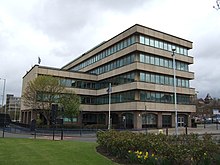
The UK's VAT Registration Service, for Value Added Tax is at HMRC in Wolverhampton. Flint Ink UK in the east of the town centre, was the largest ink supplier in the British Empire, before being bought in 1998. In Fordhouses, are HS Marston who make heat exchangers.

Turner Powertrain Systems is the world market leader for transmissions for backhoe loaders, mini excavators telescopic handlers, and site dumpers is further south, near Dunstall Hill. Tata Steel (former site of British Steel Seamless Tubes until 1995) have their Wednesfield Steelpark (the UK's biggest steelyard, built by Corus in 1999) on the Walsall boundary.
Essar Steel UK in west Dudley, is the largest independent steel toll processor in the UK.
Hadley Group near the Soho Foundry is the largest cold roll forming manufacturer in the UK. Caparo Precision Tubes in Oldbury, is the UK's largest producer of electric resistance welded (ERW) steel tubes, and Wellman Group make boilers to the west. Metsec, east of Oldbury, is one of the UK's largest cold roll-forming companies. The AA have a main office in Rounds Green, west of Oldbury. BIP Chemicals (former British Cyanides) at Oldbury are the oldest polymer manufacturer in the UK. STILL UK is in Harvills Hawthorn, Golds Hill, north-west of West Bromwich and further along the A41 is 2 Sisters Food Group, Britain's largest processor of chicken. Nesbit Evans in the east of Wednesbury, are a main manufacturer of hospital beds.

The national headquarters of One Stop is in Brownhills, at Clayhanger. Poundland is in Willenhall. Wedge Group, based in Willenhall, is the largest hot dip galvanising company in the UK. Assa Abloy UK (and Yale UK, former Yale & Towne), is also in Willenhall, as the town is known for manufacture of locks. A.F. Blakemore, supplies most of the SPAR shops in the UK.
Worcestershire

In Redditch are Halfords, to the south in Washford, and GKN (it has the second largest turnover in the West Midlands) is in Riverside. Mettis Aerospace are in Enfield, north Redditch, and make light metal components ( former High Duty Alloys, which made most of the forged pistons for Britain's aircraft engines in WWII). Phoenix Group (non-public life assurance schemes) is in the north-east of the county near the Warwickshire boundary, at Wythall, and has a large turnover; nearby to west Metalrax, headquartered in Alvechurch, make (via subsidiaries) most of the bakeware sold in the UK.

Roger Dyson Group manufactures auto-recovery vehicles in north Droitwich. South of Bromsgrove, L.G. Harris & Co make paintbrushes. Lea & Perrins is in Worcester. Joy Mining Machinery are in the west of Worcester. Worcester, Bosch Group make 1,200 boilers a day. Mazak UK have the parent company's European manufacturing facility (for CNC machine tools) in the north of Worcester. Nearby on the Blackpole Ind Est, Froude Hofmann have their world headquarters, who make dynamometers.
Roxel UK develops solid-fuel rockets for missiles south of Kidderminster and in Hartlebury. The West Midland Safari Park is in Bewdley, west of Kidderminster. Morgan Technical Ceramics is headquartered at Lickhill in Stourport-on-Severn. Egbert H. Taylor in Elmley Lovett, near Hartlebury is a manufacturer of metal bins.

Liquid crystal displays were developed in 1972 in conjunction with the Royal Radar Establishment, where Geoffrey Dummer invented the idea of the integrated circuit in 1952. It was based in Malvern, and became the Royal Signals and Radar Establishment, which developed thermal imaging and pyroelectric infrared detectors, and is now a large site owned by QinetiQ. Morgan Motor Company is in Malvern Link. Commsoft RMS is in Evesham. For many years Group 4 Security, which was the largest security company in Europe, had its headquarters in Broadway, on the edge of the Cotswolds; G4S Integrated Services now has its HQ there.
Education
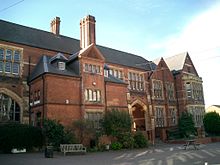

This section needs additional citations for verification. (January 2017) |
Secondary education
Selective schools are in low numbers as follows: Birmingham (8), Walsall (2), Wolverhampton (1), Warwickshire (6), Stoke-on-Trent (1), and Telford and Wrekin (2). The highest proportion per head therefore is Warwickshire (its population is between 550,000 and 600,000 people). The other counties and metropolitan boroughs have none, their public education systems are comprehensive in intake. The grammar and independent schools tend to produce pass-rate examination results among the top twenty ranked regionally. Many pupils compete for entrance examinations to attend such long-established Grammar Schools and most have significant parent sponsorship. In 2016 two of the top ten such schools nationally were in Warwickshire, where in the CV37 postal district prices were 34% higher than the county as a whole.[63] The top 20 schools at A-level rarely change from year to year; slightly lower in the table pass-rate boosts and top grades regularly occur among the schools receiving industrial funding, with similar frequency to London, the North East, and the North West, particularly in schools and academies which have some of the most advanced facilities.
Around 275,000 secondary schools are in the region, the greatest number after the South East, Greater London and North West.
At GCSE based on % of entrants' pass rates, the best performing local government area in 2010 was Solihull, closely followed by Warwickshire and Shropshire. Dudley, Herefordshire, Telford and Wrekin, Birmingham and Staffordshire (in descending order) are above the English average, at which rate, is approximately Worcestershire. The area consistently having fewest passes is Sandwell, followed by Stoke-on-Trent. Struggling pupils in Wolverhampton and Walsall also attain fewer passes than the English average in most GCSE years, sometimes by a very narrow margin. For metropolitan boroughs, Solihull then Dudley perform best. Dudley is the best metropolitan borough at A-level passes and has a consistent post-2000 history of being better than Solihull.[citation needed]
Schools have been off-rolling pupils.[64] Pupils likely to do badly in examinations are expelled before the examinations to improve the school performance in league tables. Expelled pupils then disproportionately get involved in gangs and in crime. Knife crime in the West Midlands is the highest outside London.[65]
At A-level in 2010, the consistently best performing area was Herefordshire where most A-level candidates attend Hereford sixth form college. Dudley is also above the English average; the other metropolitan boroughs have low-to-average A-level pass or high mark proportions. Shropshire is at the English average.
Regionally in persistent truancy at secondary school, Sandwell had the highest rate at 6.9%; Bromsgrove had the lowest at 2.3%.[66]
Tertiary education
There are thirty-seven FE colleges (FECs).[67] There are six LSCs for the area (which fund FECs), and the Learning and Skills Council head office is based in Coventry. The five largest FE colleges in the region – Bournville College, North Warwickshire and Hinckley College, Solihull College, South & City College Birmingham and Stoke-on-Trent College – each have more than 25,000 students.
School children in Shropshire and Solihull are most likely to attend university, followed by Herefordshire, Worcestershire and Warwickshire.
School league tables
Below is a list of the top twenty state schools in the West Midlands by 2010 A level results:[needs update]
- 1. King Edward VI Camp Hill School for Girls, Kings Heath (1212)
- 2. Sutton Coldfield Grammar School for Girls
- 3. King Edward VI Five Ways, Bartley Green
- 4. King Edward VI Camp Hill School for Boys, Kings Heath
- 5. Stratford-upon-Avon Grammar School for Girls
- 6. Queen Mary's Grammar School, Walsall
- 7. King Edward VI College, Stourbridge
- 8. Newport Girls High School
- 9. King Edward VI Handsworth
- 10. King Edward VI School, Stratford-upon-Avon
- 11. King Edward VI Aston
- 12. Bishop Vesey's Grammar School, Sutton Coldfield
- 13. Wolverhampton Girls' High School
- 14. Thomas Telford School, Telford
- 15. St. Joseph's College, Stoke-on-Trent
- 16. Queen Mary's High School, Walsall
- 17. Rugby High School for Girls
- 18. St Augustine's High School, Redditch
- 19. Hereford Sixth Form College
- 20. Moorlands Sixth Form College, Cheadle, Staffordshire
Universities
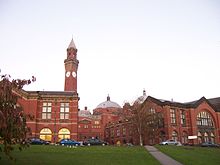

| University | Students | National Ranking (2017)[68] |
|---|---|---|
| University of Birmingham | 34,835 | 13 |
| Coventry University | 31,690 | 54 |
| University of Warwick | 25,615 | 11 |
| Birmingham City University | 24,130 | 84 |
| University of Wolverhampton | 19,560 | 121 |
| Staffordshire University | 14,910 | 75 |
| Aston University | 14,162 | 43 |
| University of Worcester | 10,745 | 97 |
| Keele University | 10,600 | 104 |
| Harper Adams University | 5,410 | 41 |
| University College Birmingham | 4,935 | – |
| Newman University | 2,830 | 120 |
The University of Birmingham is the main university in the region[69] and has the most funding. It has a large research grant, as does the University of Warwick, which is the next largest in terms of funding. Birmingham and Warwick are members of the Russell Group of public research universities. Keele and Aston have a moderate research grant, but none of the other universities do. Keele, although having the largest campus in the UK (by area), is one of the smallest universities in the region. There are medical schools at Warwick, Keele and Birmingham. Birmingham and Warwick receive more than twice as much total income than any other university in the region – around £400 million each.
Around 45% of students are from the region, and 35% from other parts of the UK, while 20% are from overseas. The region attracts students from South East England owing to good access via the M40 and the West Coast Main Line, but there is a good mix from other regions too, except the North East (especially) and Yorkshire. Students native to the West Midlands are most likely to study in the region (40%), then the East Midlands (12%), the North West (11%), and then Yorkshire (9%). Very few go to the East of England or the North East. The region has a net export of university students to other regions.
At time of graduation in 2010 almost 60% of graduates remained in the West Midlands, with 10% going to London, 7% to the South-East, and around 5% to the East Midlands. Very few go to Yorkshire, the North-East, or even (neighbouring) Wales.
Transport
Railways
Served by many lines in the urban areas such as the West Coast Main Line and branches. The Welsh Marches Line and the Cotswold Line transect the region as well as the Cross Country Route and Chiltern Line. There are plans to reopen the Gloucestershire Warwickshire Railway [citation needed]. The HS2 (High Speed Two) project is planned to connect London to Birmingham by 2026.
Road
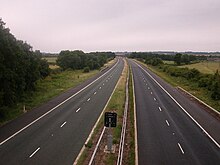
Several notable roads pass through the region, with most converging around the central conurbation. The M5, which connects South West England to the region, passes through Worcestershire, near to Worcester, and through the West Midlands county, past West Bromwich, with its northern terminus at its junction with the M6 just south of Walsall. The M6, which has its southern terminus just outside the southeast of the region at its junction with the M1, and which connects the region to North West England, passes Rugby and Nuneaton in Warwickshire, Coventry and Birmingham, and Stafford and Stoke-on-Trent in Staffordshire. The M6 toll provides an alternative route to the M6 between Coleshill and Cannock, passing north of Sutton Coldfield and just south of Lichfield. The M40 connects the region through South East England to London, with its northern terminus at its junction with the M42; it passes close to Warwick and Banbury. The M42 connects the M5 at Bromsgrove, passing around the south and east of Birmingham, joining the M40 and M6, passing Solihull and Castle Bromwich, to Tamworth, northeast of Birmingham. The M50 connects the M5 from near Tewkesbury to Ross-on-Wye in the southwest. The M54 connects Wellington in the west, passing Telford, to the M6 near Cannock. The A5 road traverses the region northwest–southeast, passing through Shrewsbury, Telford, Cannock, Tamworth and Nuneaton.
The longest elevated road viaduct in the UK is the 3 miles (4,779 m) section from Gravelly Hill to Castle Bromwich on the M6, opened on 24 May 1972; the 3.5 miles (5.6 km) Bromford Viaduct is the longest viaduct in the UK. The section of the A45 in Coventry from Willenhall to Allesley in 1939 was one of the UK's first ever large planned road schemes; road schemes on that scale had not been previously built, with few large road schemes outside of London, or were piecemeal.
Princes Square in Wolverhampton had Britain's first automatic traffic lights on 5 November 1927.[70] On 13 January 2012, 34-year-old Ben Westwood of Wednesfield, was caught by the police, when speeding at 180 mph, in an Audi RS5 with a Lamborghini engine, from Wolverhampton up to Stafford on the M6, and back again. He was travelling so fast that he was outpacing the Central Counties Air Operations Unit Eurocopter helicopter. He and the vehicle had been in fifteen smash and grab raids and he was jailed for nine years at Wolverhampton Crown Court in August 2012.[71]
Transport policy
As part of the transport planning system, the Regional Assembly is under statutory requirement to produce a regional transport strategy (RTS) to provide long term planning for transport in the region. This involves region-wide transport schemes such as those carried out by Highways England and Network Rail.[72]
Within the region, the local transport authorities carry out transport planning through the use of a local transport plan (LTP) which outlines their strategies, policies and implementation programme.[73] The most recent LTP is that for the period 2006–11. In the West Midlands region, the following transport authorities have published their LTP online: Herefordshire,[74] Shropshire U.A.,[75] Staffordshire,[76] Telford and Wrekin U.A.,[77] Warwickshire,[78] West Midlands[79] and Worcestershire.[80] The transport authority of Stoke-on-Trent U.A. publishes a joint local transport plan in partnership with Staffordshire County Council to cover the North Staffordshire Major Urban Area, which includes Stoke-on-Trent and the more urban parts of Newcastle-under-Lyme and Staffordshire Moorlands.[81]
Media
Television

The West Midlands region of the BBC is based at the Mailbox in Birmingham. From there, the regional programme Midlands Today is produced, as well as the BBC'S flagship daytime series Doctors.[82] ITV Central broadcasts from Birmingham, off Broad Street on Gas Street next to the Worcester and Birmingham Canal, with its ITV News Central regional programme.
Some northern parts of the region, including Biddulph, receive BBC North West Tonight and Granada Reports both of which are based at MediaCityUK in Salford and are broadcast from the Winter Hill transmitter.
The BBC has its engineering training centre at Wood Norton, Worcestershire, off the A44 north of Evesham in Norton and Lenchwick. BBC English Regions is based at Birmingham.
Radio
BBC Local Radio
The West Midlands is served by numerous BBC Local Radio stations, including BBC WM, BBC Coventry & Warwickshire, BBC Radio Stoke, BBC Hereford & Worcester and BBC Radio Shropshire.
Commercial radio
Commercial radio stations include Free Radio, Capital Midlands, Capital Mid-Counties, Heart West Midlands, Smooth Radio West Midlands, Absolute Radio, Greatest Hits Radio, Sunshine 855 and Sunshine Radio Herefordshire & Monmouthshire.
Community Radio
Community radio stations include:
- The Bridge 102.5 (Stourbridge)
- Youthcomm Radio (Worcester)
- Big City Radio (Birmingham)
- Radio Plus and Hillz FM in (Coventry)
- WCR FM and Gorgeous Radio (Wolverhampton)
- Moorlands Radio (Leek)
- 6 Towns Radio and Cross Rhythms City Radio (Stoke-on-Trent)
- The Hitmix (Newcastle-under-Lyme)
- Cannock Chase Radio and Stafford FM (Stafford)
Stafford is also notable for Windmill Broadcasting, the UK's only radio station based in a Windmill, in the Broad Eye Windmill.
Newspapers
Local newspapers include:
- Berrow's Worcester Journal
- Birmingham Mail
- Birmingham Post
- Burton Mail
- Coventry Telegraph
- Express & Star (Wolverhampton)
- Nuneaton News
- Shropshire Star
- The Sentinel (Stoke-on-Trent)
- The Shuttle (Kidderminster based, reporting on Wyre Forest news, Worcestershire)
- Worcester News
Magazines
William Gibbons of Wolverhampton prints New Scientist, The Lady, Farmers Weekly, BBC Focus, Psychologies, History Revealed, Classic Rock, and Tractors & Machinery.[citation needed]
The Polestar Varnicoat works on the A44 in Pinvin, north of Pershore, for many years[when?] printed Woman's Own, Heat, Pick Me Up, Chat, and That's Life.
Online
Channel 4's 4Talent network has a hub in the West Midlands dealing with rising media talent from the region.[83]
Sport
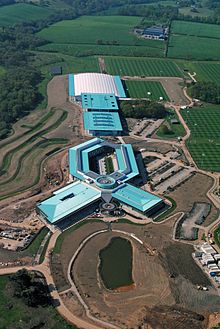
The National Sports Centre at Lilleshall Hall is in Sheriffhales, Shropshire, north-east of Telford; it was largely established by the Central Council of Physical Recreation in 1949 as a National Recreation Centre; the south of England had theirs at Bisham Abbey on the Thames. St George's Park National Football Centre is at Tatenhill near Byrkley Park in Needwood Forest, near former the RAF Tatenhill off the A515, four miles west of Burton upon Trent.
The Tough Guy Competition, now a widespread sport competition in the US, began in 1987 on a farm at Perton in Staffordshire. The main British athletics championships are held in Birmingham in late June. The Olympic Movement started at Much Wenlock, and also to the east of region, where Baron de Coubertin formulated his ideas for sport and the Olympics at Rugby School in 1883, with the headmaster Thomas Arnold, whose son would be the famous poet Matthew Arnold and whose great-grandson would be Aldous Huxley.
Football
| Club | League | City/Town | Stadium | Capacity |
|---|---|---|---|---|
| Aston Villa FC | Premier League | Birmingham | Villa Park | 42,788 |
| Wolverhampton Wanderers F.C. | Premier League | Wolverhampton | Molineux Stadium | 31,700 |
| Birmingham City F.C. | EFL Championship | Birmingham | St Andrew's | 30,079 |
| Stoke City FC | EFL Championship | Stoke-on-Trent | Bet365 Stadium | 28,384 |
| West Bromwich Albion FC | EFL Championship | West Bromwich | The Hawthorns | 26,500 |
| Burton Albion F.C. | League One | Burton-upon-Trent | Pirelli Stadium | 6,912 |
| Coventry City FC | EFL Championship | Coventry | Coventry Building Society Arena | 32,609 |
| Shrewsbury Town F.C. | League One | Shrewsbury | New Meadow | 9,875 |
| Walsall F.C. | League Two | Walsall | Bescot Stadium | 11,300 |
| Port Vale F.C. | League One | Stoke-on-Trent | Vale Park | 19,052 |
| Solihull Moors | National League | Solihull/Birmingham | The ARMCO Stadium | 3,050 |
| A.F.C. Telford United | National League North | Telford | New Bucks Head | 6,300 |
| Hereford F.C. | National League North | Hereford | Edgar Street | 4,913 |
| Kidderminster Harriers F.C. | National League North | Kidderminster | Aggborough | 6,250 |
| Nuneaton Town F.C. | Southern League Premier Division Central | Nuneaton | Liberty Way | 4,314 |
| Leamington F.C. | National League North | Whitnash | New Windmill Ground | 5,000 |
Rugby
In rugby union, the region is home to professional Premiership teams Wasps RFC and Worcester Warriors. In rugby league, Midlands Hurricanes play in the third tier League 1.
Tennis

Britain's first tennis club was founded in 1872 in Leamington Spa. The modern rules of lawn tennis were developed in 1874 by Leamington Tennis Club. Tennis was pioneered in Edgbaston in 1859, and Edgbaston Archery and Lawn Tennis Society also claims to be the oldest tennis club in the world, where tennis was invented by Major Harry Gem and the Spaniard Augurio Perera.[citation needed]
Motor sport
Team Dynamics at Pershore, has won the British Touring Car Championship.
Notes
References
- "Home – Office for National Statistics". www.statistics.gov.uk. Archived from the original on 21 April 2007. Retrieved 19 March 2008.
- "United Kingdom: Urban Areas in England". City Population. Retrieved 14 September 2022.
- "Black Country Living Museum". Black Country Living Museum. Archived from the original on 3 April 2013. Retrieved 3 April 2013.
- "The Iron Bridge". Ironbridge Gorge Museum Trust. Archived from the original on 21 March 2013. Retrieved 3 April 2013.
- "1881to1911". www.btplc.com. Archived from the original on 14 July 2014. Retrieved 10 June 2014.
- "1912to1968". www.btplc.com. Archived from the original on 14 July 2014. Retrieved 10 June 2014.
- "St Joseph makes a splash at the 2019 Nowka Bais". Berkeley Group. Archived from the original on 5 September 2019. Retrieved 5 September 2019.
- Bentley, David (29 July 2018). "Free festival with street food and dragon boat racing returns to Birmingham". Birmingham Mail. Archived from the original on 5 September 2019. Retrieved 5 September 2019.
- As UK Census data past 2001 is unavailable through the ONS website, it has been recommended to use archival census collection websites to obtain data. Data is taken from United Kingdom Casweb Data services of the United Kingdom 1991 Census on Ethnic Data for England (Table 6)
- "Office of National Statistics; 2001 Census Key Statistics". webarchive.nationalarchives.gov.uk. Retrieved 24 June 2022.
- "2011 Census: Ethnic Group, local authorities in England and Wales". webarchive.nationalarchives.gov.uk. Retrieved 24 June 2022.
- "LSOA data" (PDF). Archived from the original (PDF) on 9 June 2012.
- "Communities and Local Government 2007". Archived from the original on 13 April 2010.
- "Claimant count".[permanent dead link]
- "Election Data 1992". Electoral Calculus. Archived from the original on 15 October 2011. Retrieved 24 March 2022.
- "Election Data 2015". Electoral Calculus. Archived from the original on 17 October 2015. Retrieved 22 March 2022.
- "The Green Party: a short history". The Independent. Retrieved 24 March 2022.
{{cite news}}: CS1 maint: url-status (link) - Rootes, Chris (1995). "Britain: Greens in a Cold Climate". The Green Challenge: The Development of Green Parties in Europe. London and New York: Routledge. pp. 66–90.
- McCulloch, Alistair (1992). "The Green Party in England and Wales: Structure and Development: The Early Years". Environmental Politics 1 (3). pp. 418–436.
- County of Hereford forms single local government unit (Unitary Authority)
- "Business Link". Archived from the original on 5 October 2012.
- "MAS – Manufacturing Advisory Service". Archived from the original on 22 January 2015.
- Midl, DIT West; help, find out how DIT can. "DIT West Midlands: helping companies export and grow overseas". GOV.UK. Archived from the original on 23 August 2017. Retrieved 23 August 2017.
- "Electronic Staff Record". www.electronicstaffrecord.nhs.uk. Archived from the original on 29 June 2015. Retrieved 19 November 2015.
- Intelligence and Enforcement Directorate, The Insolvency Service, 18 The Priory Queensway, Birmingham
- HMRC Stamp Duty Taxes, City Centre House, Birmingham
- Tricorn House, 51–53 Hagley Rd, Birmingham – specifically near Five Ways.
- SRA, The Cube, Birmingham part of the Mailbox.
- H. Samuel, Hunters Road, Hockley within the Jewellery Quarter, Birmingham since 1912 "About Us". H.Samuel. Archived from the original on 14 January 2018. Retrieved 20 July 2022.
- J Hudson & Co 244 Barr Street, Boulton Middleway, Birmingham, namely in the Jewellery Quarter where the A41 and A4540 meet.
- The latter at Cannon House
- Solihull
- Head office, B4110 at Stoke Aldermoor
- Jaguar Land Rover, Whitley, Coventry
- Wharf Street, Aston, Birmingham
- "Wieland Metals Birmingham" (PDF). Archived (PDF) from the original on 13 January 2018. Retrieved 12 January 2018.
- Kiepe Electric, Aston Science Park, Birmingham
- Goodyear, 2920 Trident Court, Solihull Parkway, Birmingham Business Park, Birmingham
- 40 Fort Pkwy, Birmingham
- RoSPA, 28 Calthorpe Rd, Birmingham – specifically in Calthorpe Fields in north Edgbaston, next to St George's School
- Office/depot at the A47/A4040 junction next to the River Tame at Ward End near M6, and next to the former LDV factory.
- Genting Group, Star City near Washwood Heath.
- Goodrich Engine Controls, Hall Green, Birmingham
- in Kings Norton
- Kitts Green (towards Solihull), next to the River Cole.
- at Longbridge.
- Maypoint Business Park, next to the railway on the opposite side of the A38
- Midpoint Park, south of A38
- Sutton Coldfield
- Birmingham
- Highways England, Quinton, Birmingham.
- Ishida, Woodgate Business Park
- Severn Trent, 2 St John Street, Coventry
- Westwood Business Park in Westwood Heath
- Bladon Jets, Pinley
- Axeon UK, Coventry
- Edgwick and Great Heath
- Wayside Business Park, Longford, Coventry
- Whitmore Park, Coventry
- At Walsgrave Triangle
- Middlemarch Business Park, Baginton next to Coventry Airport
- Prologis Park, Coventry
- "Parents willing to pay £53,000 more to live near a top school" (PDF) (Press release). Lloyds Bank. 5 September 2016. Archived from the original (PDF) on 12 December 2017.
- Adams, Richard (5 December 2019). "'Off-rolling' hides true extent of disadvantage gap in schools – study". The Guardian. Retrieved 19 December 2019.
- West Midlands schools 'fuelling violent crime by excluding pupils' Archived 5 December 2018 at the Wayback Machine The Guardian
- 2010 statistics (approx.)
- "Directory of AoC member Colleges". Archived from the original on 17 August 2013.
- "Top UK University League Tables and Rankings 2019". thecompleteuniversityguide.co.uk. Archived from the original on 13 October 2013. Retrieved 17 August 2013.
- "HEFCE" (PDF). hefce.ac.uk. Archived (PDF) from the original on 12 November 2009. Retrieved 29 March 2010.
- "Princes Square – Roader's Digest: The SABRE Wiki". www.sabre-roads.org.uk. Archived from the original on 15 November 2017. Retrieved 15 November 2017.
- "Jail for 180mph M6 chase driver". BBC News. 23 August 2012. Archived from the original on 7 October 2018. Retrieved 7 October 2018.
- "Regional Transport Strategy: the National Picture". Government Office for the West Midlands. Archived from the original on 30 June 2009. Retrieved 28 April 2009.
- "The LTP Process". Department for Transport. Archived from the original on 9 October 2007. Retrieved 28 April 2009.
- "Herefordshire 2006–11 Local Transport Plan". Herefordshire Council. Archived from the original on 28 December 2008. Retrieved 5 May 2009.
- "Shropshire2006-11 Local Transport Plan". Shropshire Council. Archived from the original on 1 December 2008. Retrieved 5 May 2009.
- "Staffordshire2006-11 Local Transport Plan". Staffordshire County Council. Archived from the original on 21 November 2008. Retrieved 5 May 2009.
- "Telford and Wrekin 2006–11 Local Transport Plan". Telford and Wrekin Council. Archived from the original on 30 June 2009. Retrieved 5 May 2009.
- "Warwickshire 2006–11 Local Transport Plan". Warwickshire County Council. Archived from the original on 30 April 2009. Retrieved 5 May 2009.
- "West Midlands 2006–11 Local Transport Plan". West Midlands LTP. Archived from the original on 18 May 2009. Retrieved 5 May 2009.
- "Worcestershire 2006–11 Local Transport Plan". Worcestershire County Council. Archived from the original on 11 March 2009. Retrieved 5 May 2009.
- "Stoke-on-Trent 2006–11 Local Transport Plan". Stoke-on-Trent City Council. Archived from the original on 30 June 2009. Retrieved 5 May 2009.
- Honebeek, Talya (29 November 2021). "Where is Doctors filmed? All the BBC soap's Birmingham filming locations". Birmingham Mail. (Reach plc). Retrieved 3 September 2022.
- "C4 Opportunities | Where could your talent take you?". Archived from the original on 10 August 2014. Retrieved 15 October 2014.
{{cite web}}: CS1 maint: bot: original URL status unknown (link)
Further reading
- Bennett, Michael J. "Sir Gawain and the green knight and the literary achievement of the north-west Midlands: the historical background." Journal of Medieval History 5.1 (1979): 63–88.
- Betteridge, Alan. Deep Roots, Living Branches: A History of Baptists in the English Western Midlands (Troubador Publishing Ltd, 2010).
- Donnelly, Tom, Jason Begley, and Clive Collis. "The West Midlands automotive industry: the road downhill." Business History 59.1 (2017): 56–74 online.
- Finberg, H.P.R. The early charters of the West Midlands (Leicester University Press, 1972).
- Gelling, Margaret. The West Midlands in the Early Middle Ages (Leicester UP, 1992).
- Hilton, R. H. A Medieval Society: The West Midlands at the End of the Thirteenth Century (1987) online review
- Jones, Peter M. Industrial Enlightenment: Science, technology and culture in Birmingham and the West Midlands, 1760–1820 (2017) online.
- Money, John. Experience and Identity: Birmingham and the West Midlands, 1760–1800 (Manchester University Press, 1977).
- Money, John. "Birmingham and the West Midlands, 1760–1793: Politics and Regional Identity in the English Provinces in the Later Eighteenth Century." Midland History 1.1 (1971): 1–19.
- Rowlands, Marie B. The West Midlands from AD 1000 (3 vol, Longman, 1987).
- Somerset, Alan. "New Historicism: Old History Writ Large? Carnival, Festivity and Popular Culture in the West Midlands." Medieval & Renaissance Drama in England 5 (1991): 245–255. online
External links
- Advantage West Midlands – Regional Development Agency
- Government Office for the West Midlands
- West Midlands Regional Assembly
- Government's list of councils in the West Midlands
- MLA West Midlands – Museums, Libraries and Archives Regional Agency
- NHS West Midlands – The regional strategic health authority for the West Midlands
- Black Country Living Museum, which tells the history of the modern West Midlands areas of Dudley, Sandwell, Walsall and Wolverhampton
- The Manor of Hunningham
На других языках
- [en] West Midlands (region)
[ru] Западный Мидленд
Западный Мидленд[1] (Уэст-Мидлендс; англ. West Midlands) — регион на западе Англии. Столица и крупнейший город — Бирмингем. Другие крупные города — Ковентри, Шрусбери. Название региона по-английски совпадает с названием одного из входящих в него метропольных графств — Уэст-Мидлендс[2], однако по-русски принято первое частично переводить, что позволяет избежать некоторой путаницы.Другой контент может иметь иную лицензию. Перед использованием материалов сайта WikiSort.org внимательно изучите правила лицензирования конкретных элементов наполнения сайта.
WikiSort.org - проект по пересортировке и дополнению контента Википедии

